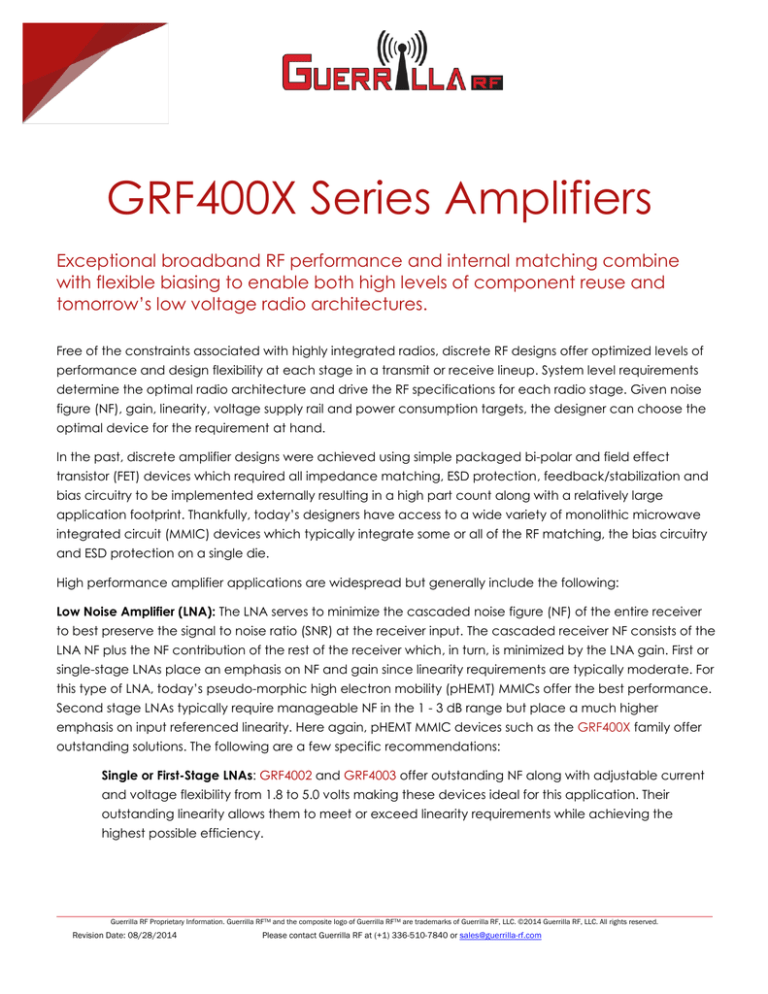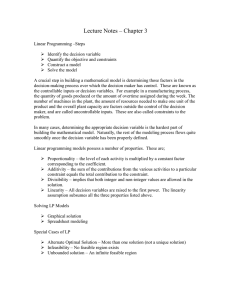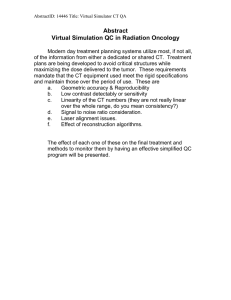
GRF400X Series Amplifiers
Exceptional broadband RF performance and internal matching combine
with flexible biasing to enable both high levels of component reuse and
tomorrow’s low voltage radio architectures.
Free of the constraints associated with highly integrated radios, discrete RF designs offer optimized levels of
performance and design flexibility at each stage in a transmit or receive lineup. System level requirements
determine the optimal radio architecture and drive the RF specifications for each radio stage. Given noise
figure (NF), gain, linearity, voltage supply rail and power consumption targets, the designer can choose the
optimal device for the requirement at hand.
In the past, discrete amplifier designs were achieved using simple packaged bi-polar and field effect
transistor (FET) devices which required all impedance matching, ESD protection, feedback/stabilization and
bias circuitry to be implemented externally resulting in a high part count along with a relatively large
application footprint. Thankfully, today’s designers have access to a wide variety of monolithic microwave
integrated circuit (MMIC) devices which typically integrate some or all of the RF matching, the bias circuitry
and ESD protection on a single die.
High performance amplifier applications are widespread but generally include the following:
Low Noise Amplifier (LNA): The LNA serves to minimize the cascaded noise figure (NF) of the entire receiver
to best preserve the signal to noise ratio (SNR) at the receiver input. The cascaded receiver NF consists of the
LNA NF plus the NF contribution of the rest of the receiver which, in turn, is minimized by the LNA gain. First or
single-stage LNAs place an emphasis on NF and gain since linearity requirements are typically moderate. For
this type of LNA, today’s pseudo-morphic high electron mobility (pHEMT) MMICs offer the best performance.
Second stage LNAs typically require manageable NF in the 1 - 3 dB range but place a much higher
emphasis on input referenced linearity. Here again, pHEMT MMIC devices such as the GRF400X family offer
outstanding solutions. The following are a few specific recommendations:
Single or First-Stage LNAs: GRF4002 and GRF4003 offer outstanding NF along with adjustable current
and voltage flexibility from 1.8 to 5.0 volts making these devices ideal for this application. Their
outstanding linearity allows them to meet or exceed linearity requirements while achieving the
highest possible efficiency.
Guerrilla RF Proprietary Information. Guerrilla RFTM and the composite logo of Guerrilla RFTM are trademarks of Guerrilla RF, LLC. ©2014 Guerrilla RF, LLC. All rights reserved.
Revision Date: 08/28/2014
Please contact Guerrilla RF at (+1) 336-510-7840 or sales@guerrilla-rf.com
Second Stage LNAs: GRF4002, GRF4003 and GRF4004, with bias currents and supply voltages
optimized for linearity, are excellent candidates for this application. Their high third order intercept
points (IP3) and 1 dB compression points (P1dB) combined with broadband NF values in the 0.7 to 1.1
dB range enable both outstanding cascaded NF and input referenced linearity for the LNA chain.
Linear Driver Amplifier: Typically found in the later part of a cascade of discrete amplifiers, these devices
provide required gain and a low distortion signal to the following higher power amplifiers. The required
linearity varies widely depending on the amplifiers place in a particular lineup; historically, these applications
have been typically addressed by hetero-junction bi-polar transistor (HBT) MMIC devices. With the advent of
our new GRF4002, GRF4003 and GRF4004, designers have powerful new pHEMT based solutions offering
outstanding broadband linearity over frequency and supply voltage thus enabling the highest level of
component reuse within a particular design as well as across differing platforms.
Intermediate Frequency (IF) Amplifier: This application typically requires a combination of high gain, high
linearity and low NF in order to minimize the cascaded NF of an IF based radio architecture while introducing
minimal distortion to the amplified signal. A common example here would be a low noise, high linearity
amplifier immediately preceding a high insertion loss IF surface acoustic wave (SAW) filter. Their broadband
linearity, NF and internal matching make the GRF4002 and GRF4003 devices ideal for such applications.
General Purpose Amplifier: Often the amplifiers within a cascaded chain need only provide gain with
minimal NF and linearity requirements. This is typically the domain of low cost Darlington gain blocks which
operate at a fixed bias current with a rigid supply voltage of 5.0 volts. Superior candidates for this type of
application would be the GRF4001, GRF4002 and GRF4003 devices which provide high gain and outstanding
linearity over a range of Vdd from 1.8 to 5.0 volts and with Iddq levels in the 20 to 100 mA range. This biasing
flexibility allows the device efficiency to be optimized for a given linearity requirement and results in a
superior low cost solution for general purpose amplification. In short, this family of devices represent a vast
improvement over today’s commonly used high-end Darlington gain blocks in terms of performance, design
flexibility, reuse and cost.
Local Oscillator (LO) Buffer Amplifier: High performance mixer LO drive level requirements can reach +20
dBm or more. With output P1dB levels up to +25 dBm (GRF4004), the GRF400X family of devices qualify as
excellent LO buffer design solutions.
Measured evaluation board linearity data plots for the GRF4003 is shown on the following page. Note the
exceptional device linearity over a range of Vdd values from 5.0 volts down to 1.8 volts. Although not shown,
gain and NF performance is very flat over Vdd and Iddq variation. This low voltage capability is common to
all the GRF400X devices. Please refer to the GRF400x data sheets for more detailed characterization data
including performance over temperature.
Guerrilla RF Proprietary Information. Guerrilla RFTM and the composite logo of Guerrilla RFTM are trademarks of Guerrilla RF, LLC. ©2014 Guerrilla RF, LLC. All rights reserved.
Revision Date: 08/28/2014
Please contact Guerrilla RF at (+1) 336-510-7840 or sales@guerrilla-rf.com
Measured Linearity Data; GRF4003 Evaluation Board:
GRF4003 OP1dB vs. Frequency and Vdd
26
OP1dB (dBm)
24
5.0 V; Iddq: 97 mA
22
4.5 V; Iddq: 96 mA
20
18
3.6 V; Iddq: 72 mA
16
3.3 V; Iddq: 69 mA
14
3.0 V; Iddq: 66 mA
12
2.7 V; Iddq: 64 mA
10
700
1960
2600
Freq (MHz)
3600
1.8 V; Iddq: 56 mA
OIP3 (dBm)
GRF4003 OIP3 vs. Frequency and Vdd
44
43
42
41
40
39
38
37
36
35
34
33
32
5.0 V; Iddq: 97 mA
4.5 V; Iddq: 96 mA
3.6 V; Iddq: 72 mA
3.3 V; Iddq: 69 mA
3.0 V; Iddq: 66 mA
700
1960
2600
Freq (MHz)
3600
2.7 V; Iddq: 64 mA
1.8 V; Iddq: 56 mA
Conclusion: Not limited by difficult external matching, dependence on a fixed supply rail or quiescent
current and with broadband frequency capability to 3800 MHz, these devices offer unmatched levels of
reuse. Used as an LNA, driver amplifier, general purpose gain block, IF amplifier or LO buffer, their low
voltage capability provides high performance support for applications using supply rails down to an
incredibly low 1.8 volts. Their outstanding low voltage IP3, P1dB, NF and gain will enable the ultra-high
efficiency radio architectures of tomorrow.
Internal matching results in a minimal number of external components and all three devices utilize a
common 1.5 x 1.5 mm DFN package and evaluation board. The Guerrilla RF applications engineering team
is always available to provide device recommendations, tuned evaluation boards, measured device data
and design assistance as needed.
Guerrilla RF Proprietary Information. Guerrilla RFTM and the composite logo of Guerrilla RFTM are trademarks of Guerrilla RF, LLC. ©2014 Guerrilla RF, LLC. All rights reserved.
Revision Date: 08/28/2014
Please contact Guerrilla RF at (+1) 336-510-7840 or sales@guerrilla-rf.com







